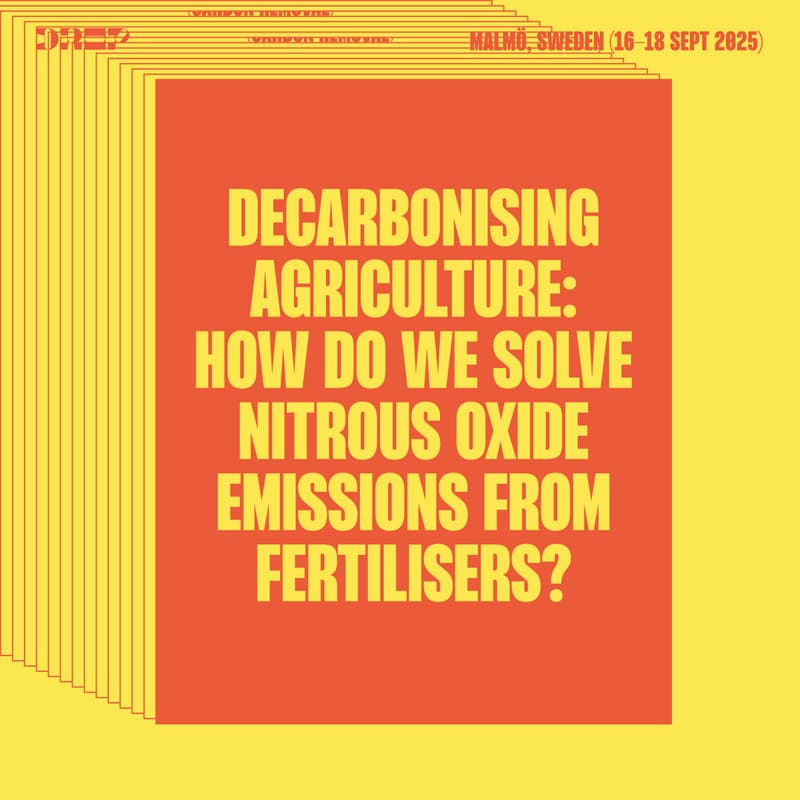

Decarbonising agriculture: how do we solve nitrous oxide emissions from fertilisers?
Ripple Hosts
Sarah Jones
Zero Carbon Capital
Daniel Skaven Ruben
Solvable Syndicate
TL;DR
Synthetic nitrogen fertilisers are a major source of potent N₂O emissions, hindering agricultural decarbonisation. This discussion will explore innovative solutions, analyse what's working and what's not, address adoption blockers like farmer incentives and VC timelines, and aim to identify scalable solutions and investment opportunities in this critical area.
Topic overview
Why is the topic relevant?
Synthetic nitrogen fertilisers are a cornerstone of modern agriculture, significantly boosting crop yields to feed a growing global population. However, their use is also a major source of nitrous oxide (N₂O), a greenhouse gas with a global warming potential approximately 265-298 times that of CO₂ over a 100-year period.
Nitrous oxides emissions from agriculture are 2 Gt/year CO2e and a substantial portion of agricultural N₂O emissions directly originates from the application and management of synthetic nitrogen fertilisers. Reducing these emissions offers a direct and impactful pathway to agricultural decarbonisation. However, mitigating fertiliser-related N₂O emissions while maintaining crop production is a major challenge.
This challenge is spurring innovation in areas like precision agriculture, enhanced efficiency fertilisers, biological nitrogen fixation, and nutrient management technologies, creating exciting investment opportunities for venture capital and startups. What will it take for these technologies to succeed? Given the scale of the challenge, it is worth discussing the technologies, incentives, and blockers for solving the nitrous oxide problem.
What’s up for discussion?
This Ripple will delve into the complexities of reducing nitrous oxide emissions from synthetic nitrogen fertilisers, structured around key themes:
Categories of Solutions:
What are these? What has worked? What has faced challenges? We will map the landscape of existing and emerging solutions aimed at reducing N₂O emissions from fertilisers. This includes:
Optimised Application: Precision agriculture techniques (variable rate application, sensor-based monitoring, timing, placement).
Enhanced Efficiency Fertilisers (EEFs): Nitrification inhibitors, urease inhibitors, slow-release fertilisers.
Alternative Nitrogen Sources: Bio-based fertilisers, organic amendments, biological nitrogen fixation technologies.
Case Studies:
Ripple participants are encouraged to share case studies and specific examples of companies and solutions, both those that have achieved notable success and those that have faced significant challenges or even failure in the realm of fertiliser-related N₂O mitigation.
Blockers and How to Overcome Them:
We will discuss the challenges facing the solutions and what can be done to overcome them, such as:
Needing sufficient incentives for farmers and overcoming their aversion to adopting new practices
A mismatch in agricultural and VC timelines
What regulatory changes are needed to encourage adoption of new technologies
Lack of accessible and accurate N₂O monitoring technologies and data
Dream outcome
Synthesise a richer, more comprehensive understanding of the landscape by leveraging the collective intelligence of founders, corporates, scientists, and VCs.
Identify the qualities to look for in existing and emerging solutions that could be successful at scale.
Generate new ideas for identifying challenges and encouraging founders and investors to work on the nitrous oxide problem.
Who should attend?
Venture Capitalists & Investors: Seeking opportunities in, or curious about, sustainable fertiliser technologies and precision agriculture.
Startup Founders & Entrepreneurs: Developing innovative solutions related to fertiliser efficiency, alternative nitrogen sources, and nutrient management.
Fertiliser Manufacturers & Suppliers: Exploring and investing in enhanced efficiency and sustainable fertiliser options.
Researchers & Scientists: Focused on nitrogen cycling, fertiliser efficiency, and N₂O emission mitigation.
Policymakers & Regulators: Interested in strategies to reduce greenhouse gas emissions from fertiliser use.
Farmers & Growers (innovators and early adopters): Interested in learning about and implementing strategies for reducing their environmental footprint.